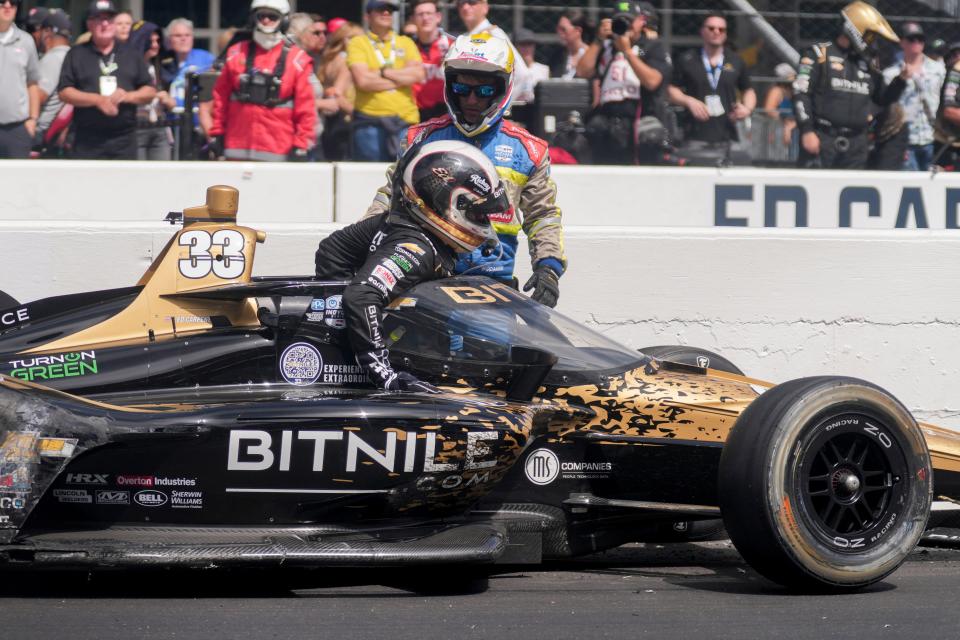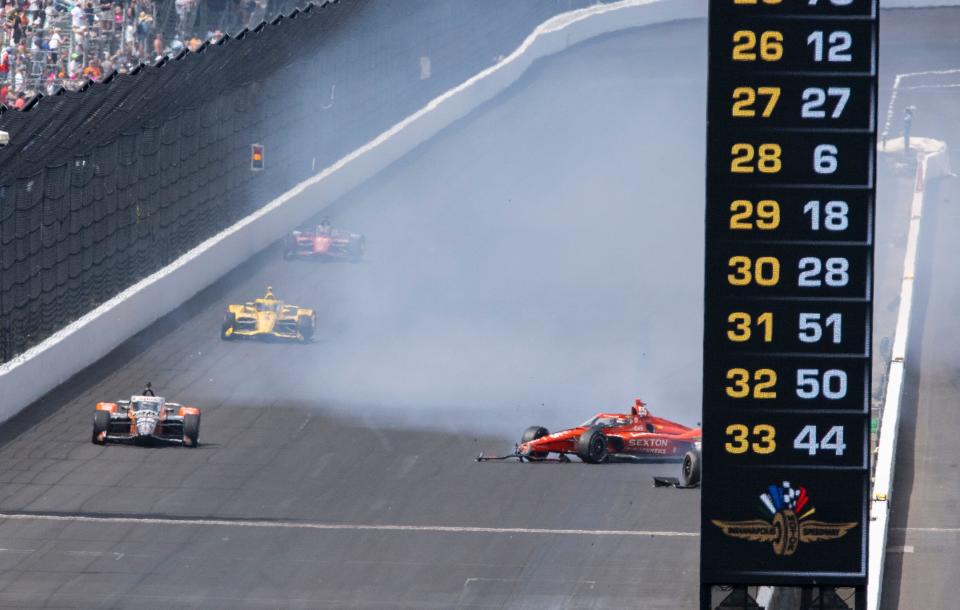'It's like the Wild West out there." IndyCar drivers want more policing from race control
DETROIT – Frustrations with what many drivers deemed IndyCar race control’s delayed call for a red flag in Sunday’s Indianapolis 500 continued to linger as the paddock loaded into downtown Detroit on Friday. But, as drivers explained, it’s merely the tip of the iceberg.
During the closing laps of Josef Newgarden’s breakthrough 500 win Sunday, drivers have pointed out a variety of things, they say, add up to a lawlessness on the racetrack that goes beyond the intensity of the Indy 500, and they’ll continue until race control decides to get more firm with how they police on-track action.

“It’s wild. I think there’s not as much respect as there has been at other times in my career, and the way things are officiated now, I think guys think they can get away with whatever they want,” IndyCar veteran owner and driver Ed Carpenter told IndyStar this week. “Guys have to understand the nature of the beast. I think there were guys out there (during the 500) who thought they were going to win the race with five laps to go from 15th.
“It’s like, ‘Come on.’ I don’t think guys are driving with enough perspective of what’s going to come, and it’s more about what the standards are and how the races are officiated. They let us get the gloves off, and personally, I’d like to see some more calls made on a regular basis. Then, I think things would sort themselves out.”
'You are (******). End of story': Why IndyCar race control bungled Indy 500 red flag call
'That's the scariest thing': Roger Penske, IndyCar investigating cause of loose wheel in 500
Asked whether he thought it was a ‘young guns vs. the old guard’ battle of philosophies NASCAR has been dealing with of late, Carpenter didn’t think the divide was nearly that clean. Graham Rahal, though, felt as if things were starting to trend that way, with 17 of the 27 full-time (or nearly full-time) drivers began their full-time IndyCar careers since the start of 2019, and 11 of those are 24 or younger.
“The mentality is changing. The younger drivers are purely more aggressive. They’re trained to not think about the consequences as much,” the 34-year-old Rahal told IndyStar. “You see this worldwide with drivers. They don’t think about the consequences like Tony Kanaan would’ve trained me. It’s becoming a sport that rewards the brave more than the thinker, even though ultimately the thinking in (Josef Newgarden) won (the 500).
“But a lot of (expletive) had to happen to get to that.”

Many of Sunday’s incidents involved that group of younger or less-experienced drivers, including rookie Sting Ray Robb losing control and grip after getting passed by Rahal. Rinus VeeKay and Colton Herta made mental mistakes in pitlane and made contact with drivers that derailed their winning hopes. Romain Grosjean spun into the Turn 2 wall. Similar to Robb, Rosenqvist couldn’t recover a Turn 1 slide up into the marbles and collected Kyle Kirkwood in the process. Pato O’Ward attempted — and ultimately failed — to make a daring pass on Marcus Ericsson for second-place with under 10 laps to go. And Christian Lundgaard sandwiching Carpenter in between he and Marco Andretti initiated the multi-car crash on the front stretch with four laps to go that led to the final controversial red flag.
Dangerous love: Indy 500 spent with Felix Rosenqvist's girlfriend ends in terrifying crash
O'Ward on pinch from Ericsson: '(Next time) he'll make friends with the wall'
And outside those obvious incidents, several drivers came away from Sunday increasingly frustrated with the lack of policing around restarts, where, as Scott Dixon explained, some folks in the mid-pack were gaining as many as 10 spots by putting the throttle to the floor ahead of when the green flag had been thrown or before the leader began to accelerate the field in the north short chute toward the Yard of Bricks.
“I just feel like there’s no repercussions for anything at the moment. They let everything fly,” said Dixon, who finished sixth in Sunday’s 500. “I mean, the restarts were atrocious. The leader, I think, has the right to do what they want to do, but you have guys making up nine or even 10 spots, and it’s like the Wild West out there.
“And when you’re doing 240 mph, that’s not a good thing.”
Said Marco Andretti: “I don’t remember the last time there was a penalty (for jumping a restart), so I think people have been taking advantage of that. I know I was getting jumped on the restart, so I finally started doing it, too, because if you don’t, you’re going to be a sitting duck.”

That lack of policing and willingness to let the drivers have their way on-track, several have said, has ultimately led to the continued exaggeration of the closing move known as ‘The Dragon’, which sees the leader in the final couple laps of the 500 weave back-and-forth left and right down the straightaways to try and break the draft to the second-place car. Ericsson used it a year ago to fend off O’Ward in their closing two-lap duel, and Sunday nearing the start of Lap 200, the Chip Ganassi Racing driver did so again — this time actually crossing the painted dotted line meant to signify the pit commitment line.
'I forgot about being a track owner': Inside Penske's record 19th Indy win
‘I was gonna win or end up in the wall': Josef Newgarden on breakthrough Indy 500 win
After passing Ericsson headed toward Turn 3 on Lap 200, Newgarden took it one step further, diving down so far past the pit commitment line race control had chosen not to enforce the Team Penske driver was directly even with the entrance to the outer lane of the pits.
Given where the aerodynamics of the cars are nowadays, particularly with how easy it was for the second-place car to take the lead from the car in front of them, it’s a move much of the paddock has reluctantly said will continue until race control opts to outlaw it, despite how dangerous many drivers acknowledge it is to inch closer to playing ‘Chicken’ with the pit lane attenuator at IMS.
“I took it to one extreme last year, going below the white line, and then Josef took it another two steps, and it’s now gotten out of hand,” Ericsson said. “It now becomes a race toward the attenuator at 200-plus mph, and we don’t want to see someone go head-on into that. That’s not going to end well.”
Said Alexander Rossi earlier in May: “We go through all this effort red-flagging races so you have a finish for the fans, and then you have this that’s not beatable. We talk about safety and all these things. We come up with new headrest pads that drivers didn’t ask for, and that’s great and a safety advancement, but then you talk about something like this that actually could be potentially dangerous, and they’re like, ‘Nah.’”
This article originally appeared on Indianapolis Star: IndyCar: After Indy 500, drivers want more policing from race control

